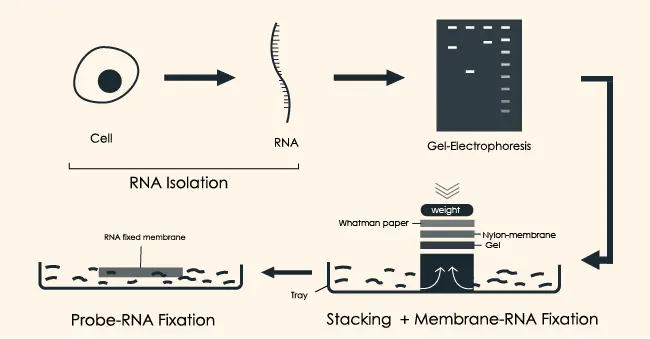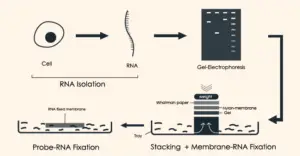
Northern Blotting, Steps Advantages All You Need To Know About.
Northern Blotting or simply Northern Blot is a pathology technique that is being used for the detection of a specific RNA molecule from the compound DNA or protein mixture. It is considered to study the RNA impression from a cell to further study the gene expression.
In very simple words, we use the northern blotting analysis technique to analyze the gene expression in a cell.
Gene expression here means, as there is the nucleus in the cell and DNA in the nucleus, this DNA express to synthesis RNA. By paying more attention to detail, we know that genes express to synthesis RNA as the DNA is the only stream of genes.
To know which gene sequence is responsible for the production of which RNA sequence, the northern blot technique is used.
For example, if we consider a cancer cell, it has low expression of cancer suppressor gene (the gene that keeps down the cancerous effect) and has a high expression of oncogenes (genes that cause cancer).
Now suppose if You want to study a specific gene in a cancer cell or You want to see how much expression shown by which gene in a cancer cell, we consider this technique.
What are the steps for northern blotting?
Northern blotting is a simple 5 step process. Following five simple steps are to be considered performing the northern blotting technique.
- RNA isolation.
- Gel Electrophoresis
- Blotting/Stacking
- Membrane-RNA fixation.
- Probe-RNA fixation.

RNA Isolation: This is the first step in northern blotting, in this step we simply isolate or separate the RNA we going to analyze from the cell or tissue.
Gel Electrophoresis: It is the 2nd step in which we electrophoresis for RNA sample just the same as we perform gel electrophoresis for DNA. The purpose to perform this is to separate RNA molecules from the other impurities present in the RNA sample. The RNA gets separated on the basis of molecular weight as it possesses a negative charge just as DNA.
The thing only different here from the apparatus of the gel electrophoresis we perform for DNA is that the agarose gel we prepare in northern blot contains an extra ingredient which is formaldehyde.
Why we use formaldehyde?
As we know RNA possesses linear form and we want our RNA in linear form. So to maintain its linear form we use formaldehyde in the gel as it helps to maintain its linear form.
Blotting/Stacking: This process aims to transfer RNA in the gel to the membrane. Special types of membranes are used on which we transfer our RNA of interest, two membranes can be used which are; nylon membrane or nitrocellulose membrane. Most often nylon membrane is used.
why we use these membranes?
These membranes are used because macromolecules like RNA, DNA, and proteins show bonding with these membranes.
In this step, we fill a tray with a transfer buffer and a sponge in it to support the gel because in this step we are going to remove the gel from the gel electrophoresis tank and place it on the sponge.
After placing the sponge in the tray filled with buffer, we place the gel on the sponge and then we place the nylon membrane which is the same size of the gel holding RNA.
After placing the gel-sized membrane on the gel, we place Whatman paper on the membrane and then place a little weight at the top which will slightly press the stack as You can see in the picture.
Membrane-RNA fixation: When we set the apparatus like this, the transfer buffer in the tray starts moving upward via capillary action. As this moves upward it drags the RNA strands present in the gel upward with itself, in this way RNA strands make the bond with the nylon membrane on the gel.
Probe-RNA fixation: After the RNA gets fixed on the nylon membrane, we remove the gel from the apparatus and place it in the tray having the probe solution.
what are probes?
Probes are short oligonucleotide sequences which are about 100-150 nucleotides long. These are stages with the detector molecule. Detector molecules are like radiolabeled staged molecules.
These probes are actually sequences complementary to our genes of interest. So if our RNA in the probe solution shows the complementary sequence to the probe, the probe then hybridizes with our RNA.
If the probes do not bind with the RNA, it means our RNA or gene of interest does not shown any expression.
What are the advantages of the northern blot?
Following are the advantages of the northern blot:
- The size of the RNA molecule can be detected specifically.
- Due to gel electrophoresis, the Quantity and quality of the RNA molecule is measureable.
- The nylon membrane used in this blot can be repeatedly reusable for years.